Strategy in the Contemporary World: Business and Market Analysis
VerifiedAdded on 2023/06/11
|8
|2817
|173
Essay
AI Summary
This essay explores the concept of strategy in the contemporary world, emphasizing its importance in various fields, including business, politics, and individual goal attainment. It highlights how strategies are used to accomplish long-term goals through careful planning and execution. The essay provides examples such as Apple Inc.'s product development and premium pricing strategies and Amazon Inc.'s 'GLOCAL' marketing strategy to illustrate practical applications. It also discusses various growth strategies like market penetration and diversification, as well as market entry strategies like mergers and acquisitions. The essay further addresses the challenges businesses face in attaining sustainable competitive advantage, discussing strategies like cost leadership, product differentiation, and focus strategies. Ultimately, the essay concludes that effective business strategies are crucial for enhancing organizational performance and achieving desired goals in the competitive business environment.
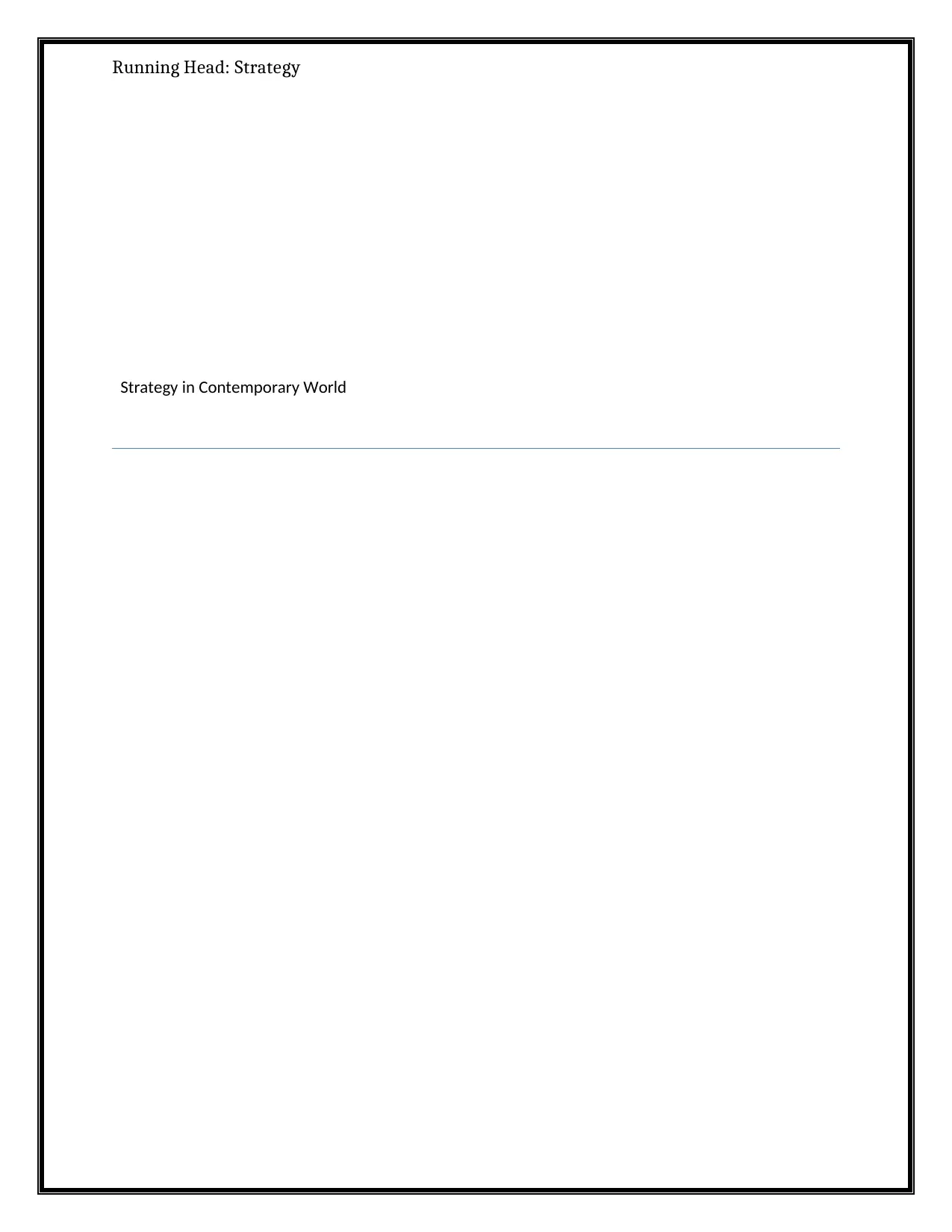
Running Head: Strategy
Strategy in Contemporary World
Strategy in Contemporary World
Paraphrase This Document
Need a fresh take? Get an instant paraphrase of this document with our AI Paraphraser
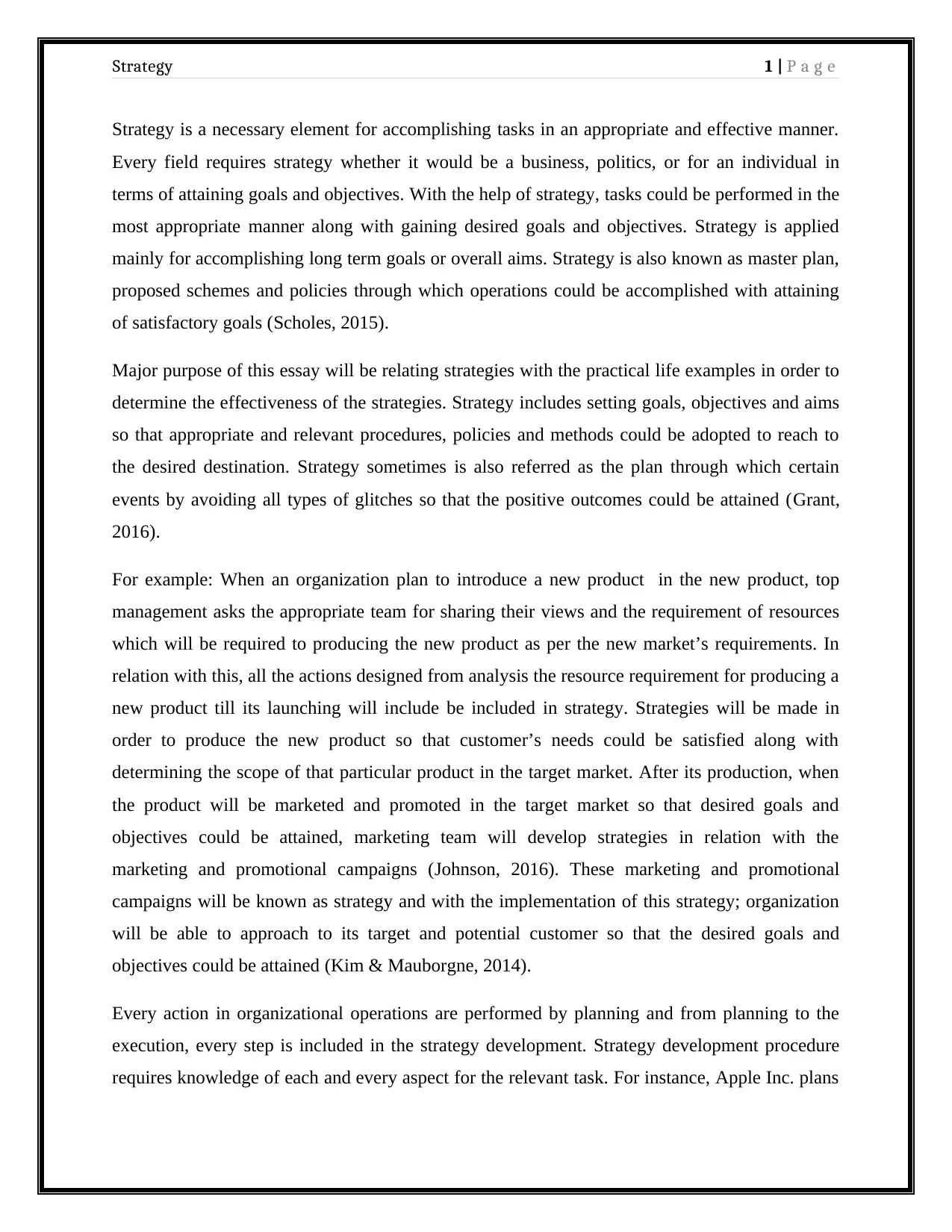
Strategy 1 | P a g e
Strategy is a necessary element for accomplishing tasks in an appropriate and effective manner.
Every field requires strategy whether it would be a business, politics, or for an individual in
terms of attaining goals and objectives. With the help of strategy, tasks could be performed in the
most appropriate manner along with gaining desired goals and objectives. Strategy is applied
mainly for accomplishing long term goals or overall aims. Strategy is also known as master plan,
proposed schemes and policies through which operations could be accomplished with attaining
of satisfactory goals (Scholes, 2015).
Major purpose of this essay will be relating strategies with the practical life examples in order to
determine the effectiveness of the strategies. Strategy includes setting goals, objectives and aims
so that appropriate and relevant procedures, policies and methods could be adopted to reach to
the desired destination. Strategy sometimes is also referred as the plan through which certain
events by avoiding all types of glitches so that the positive outcomes could be attained (Grant,
2016).
For example: When an organization plan to introduce a new product in the new product, top
management asks the appropriate team for sharing their views and the requirement of resources
which will be required to producing the new product as per the new market’s requirements. In
relation with this, all the actions designed from analysis the resource requirement for producing a
new product till its launching will include be included in strategy. Strategies will be made in
order to produce the new product so that customer’s needs could be satisfied along with
determining the scope of that particular product in the target market. After its production, when
the product will be marketed and promoted in the target market so that desired goals and
objectives could be attained, marketing team will develop strategies in relation with the
marketing and promotional campaigns (Johnson, 2016). These marketing and promotional
campaigns will be known as strategy and with the implementation of this strategy; organization
will be able to approach to its target and potential customer so that the desired goals and
objectives could be attained (Kim & Mauborgne, 2014).
Every action in organizational operations are performed by planning and from planning to the
execution, every step is included in the strategy development. Strategy development procedure
requires knowledge of each and every aspect for the relevant task. For instance, Apple Inc. plans
Strategy is a necessary element for accomplishing tasks in an appropriate and effective manner.
Every field requires strategy whether it would be a business, politics, or for an individual in
terms of attaining goals and objectives. With the help of strategy, tasks could be performed in the
most appropriate manner along with gaining desired goals and objectives. Strategy is applied
mainly for accomplishing long term goals or overall aims. Strategy is also known as master plan,
proposed schemes and policies through which operations could be accomplished with attaining
of satisfactory goals (Scholes, 2015).
Major purpose of this essay will be relating strategies with the practical life examples in order to
determine the effectiveness of the strategies. Strategy includes setting goals, objectives and aims
so that appropriate and relevant procedures, policies and methods could be adopted to reach to
the desired destination. Strategy sometimes is also referred as the plan through which certain
events by avoiding all types of glitches so that the positive outcomes could be attained (Grant,
2016).
For example: When an organization plan to introduce a new product in the new product, top
management asks the appropriate team for sharing their views and the requirement of resources
which will be required to producing the new product as per the new market’s requirements. In
relation with this, all the actions designed from analysis the resource requirement for producing a
new product till its launching will include be included in strategy. Strategies will be made in
order to produce the new product so that customer’s needs could be satisfied along with
determining the scope of that particular product in the target market. After its production, when
the product will be marketed and promoted in the target market so that desired goals and
objectives could be attained, marketing team will develop strategies in relation with the
marketing and promotional campaigns (Johnson, 2016). These marketing and promotional
campaigns will be known as strategy and with the implementation of this strategy; organization
will be able to approach to its target and potential customer so that the desired goals and
objectives could be attained (Kim & Mauborgne, 2014).
Every action in organizational operations are performed by planning and from planning to the
execution, every step is included in the strategy development. Strategy development procedure
requires knowledge of each and every aspect for the relevant task. For instance, Apple Inc. plans
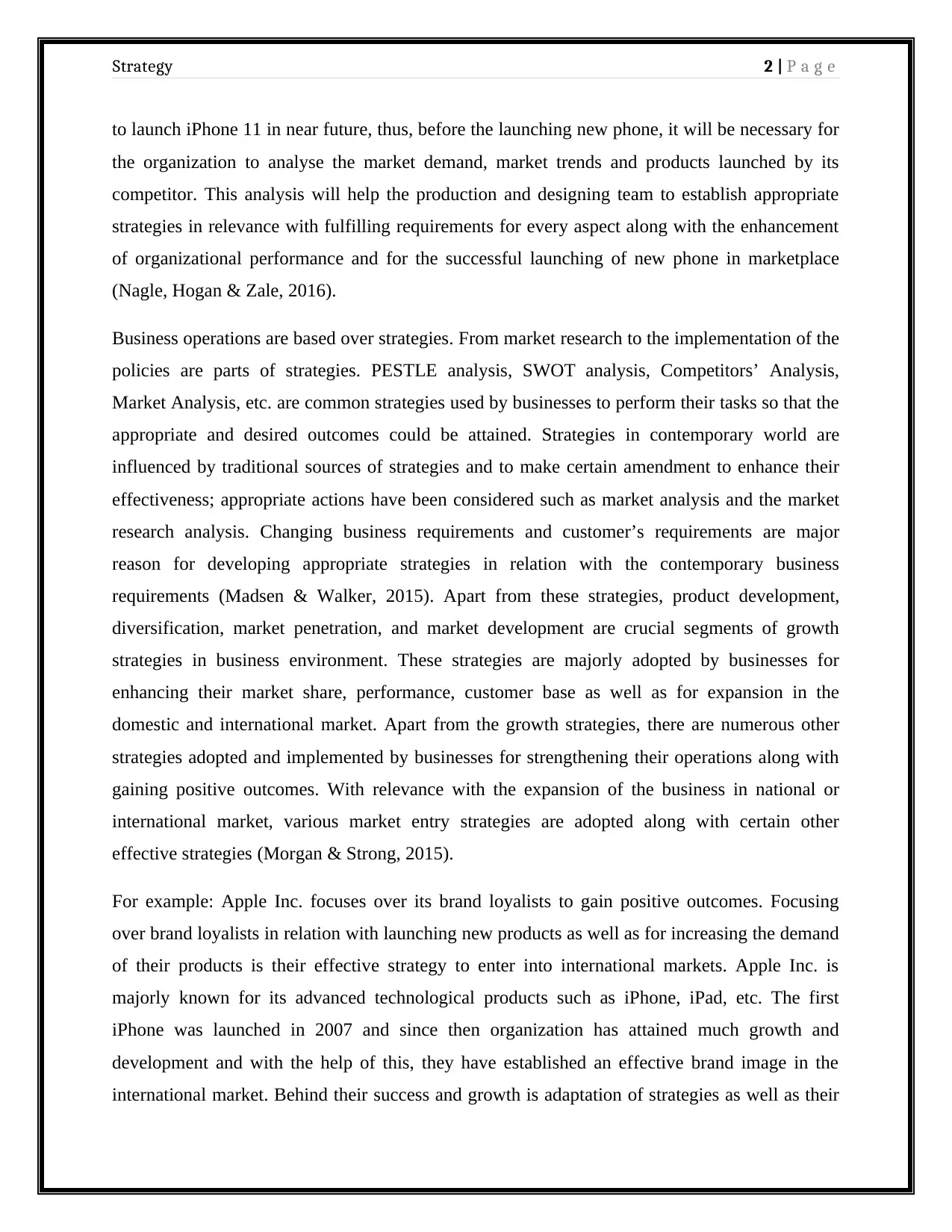
Strategy 2 | P a g e
to launch iPhone 11 in near future, thus, before the launching new phone, it will be necessary for
the organization to analyse the market demand, market trends and products launched by its
competitor. This analysis will help the production and designing team to establish appropriate
strategies in relevance with fulfilling requirements for every aspect along with the enhancement
of organizational performance and for the successful launching of new phone in marketplace
(Nagle, Hogan & Zale, 2016).
Business operations are based over strategies. From market research to the implementation of the
policies are parts of strategies. PESTLE analysis, SWOT analysis, Competitors’ Analysis,
Market Analysis, etc. are common strategies used by businesses to perform their tasks so that the
appropriate and desired outcomes could be attained. Strategies in contemporary world are
influenced by traditional sources of strategies and to make certain amendment to enhance their
effectiveness; appropriate actions have been considered such as market analysis and the market
research analysis. Changing business requirements and customer’s requirements are major
reason for developing appropriate strategies in relation with the contemporary business
requirements (Madsen & Walker, 2015). Apart from these strategies, product development,
diversification, market penetration, and market development are crucial segments of growth
strategies in business environment. These strategies are majorly adopted by businesses for
enhancing their market share, performance, customer base as well as for expansion in the
domestic and international market. Apart from the growth strategies, there are numerous other
strategies adopted and implemented by businesses for strengthening their operations along with
gaining positive outcomes. With relevance with the expansion of the business in national or
international market, various market entry strategies are adopted along with certain other
effective strategies (Morgan & Strong, 2015).
For example: Apple Inc. focuses over its brand loyalists to gain positive outcomes. Focusing
over brand loyalists in relation with launching new products as well as for increasing the demand
of their products is their effective strategy to enter into international markets. Apple Inc. is
majorly known for its advanced technological products such as iPhone, iPad, etc. The first
iPhone was launched in 2007 and since then organization has attained much growth and
development and with the help of this, they have established an effective brand image in the
international market. Behind their success and growth is adaptation of strategies as well as their
to launch iPhone 11 in near future, thus, before the launching new phone, it will be necessary for
the organization to analyse the market demand, market trends and products launched by its
competitor. This analysis will help the production and designing team to establish appropriate
strategies in relevance with fulfilling requirements for every aspect along with the enhancement
of organizational performance and for the successful launching of new phone in marketplace
(Nagle, Hogan & Zale, 2016).
Business operations are based over strategies. From market research to the implementation of the
policies are parts of strategies. PESTLE analysis, SWOT analysis, Competitors’ Analysis,
Market Analysis, etc. are common strategies used by businesses to perform their tasks so that the
appropriate and desired outcomes could be attained. Strategies in contemporary world are
influenced by traditional sources of strategies and to make certain amendment to enhance their
effectiveness; appropriate actions have been considered such as market analysis and the market
research analysis. Changing business requirements and customer’s requirements are major
reason for developing appropriate strategies in relation with the contemporary business
requirements (Madsen & Walker, 2015). Apart from these strategies, product development,
diversification, market penetration, and market development are crucial segments of growth
strategies in business environment. These strategies are majorly adopted by businesses for
enhancing their market share, performance, customer base as well as for expansion in the
domestic and international market. Apart from the growth strategies, there are numerous other
strategies adopted and implemented by businesses for strengthening their operations along with
gaining positive outcomes. With relevance with the expansion of the business in national or
international market, various market entry strategies are adopted along with certain other
effective strategies (Morgan & Strong, 2015).
For example: Apple Inc. focuses over its brand loyalists to gain positive outcomes. Focusing
over brand loyalists in relation with launching new products as well as for increasing the demand
of their products is their effective strategy to enter into international markets. Apple Inc. is
majorly known for its advanced technological products such as iPhone, iPad, etc. The first
iPhone was launched in 2007 and since then organization has attained much growth and
development and with the help of this, they have established an effective brand image in the
international market. Behind their success and growth is adaptation of strategies as well as their
⊘ This is a preview!⊘
Do you want full access?
Subscribe today to unlock all pages.

Trusted by 1+ million students worldwide
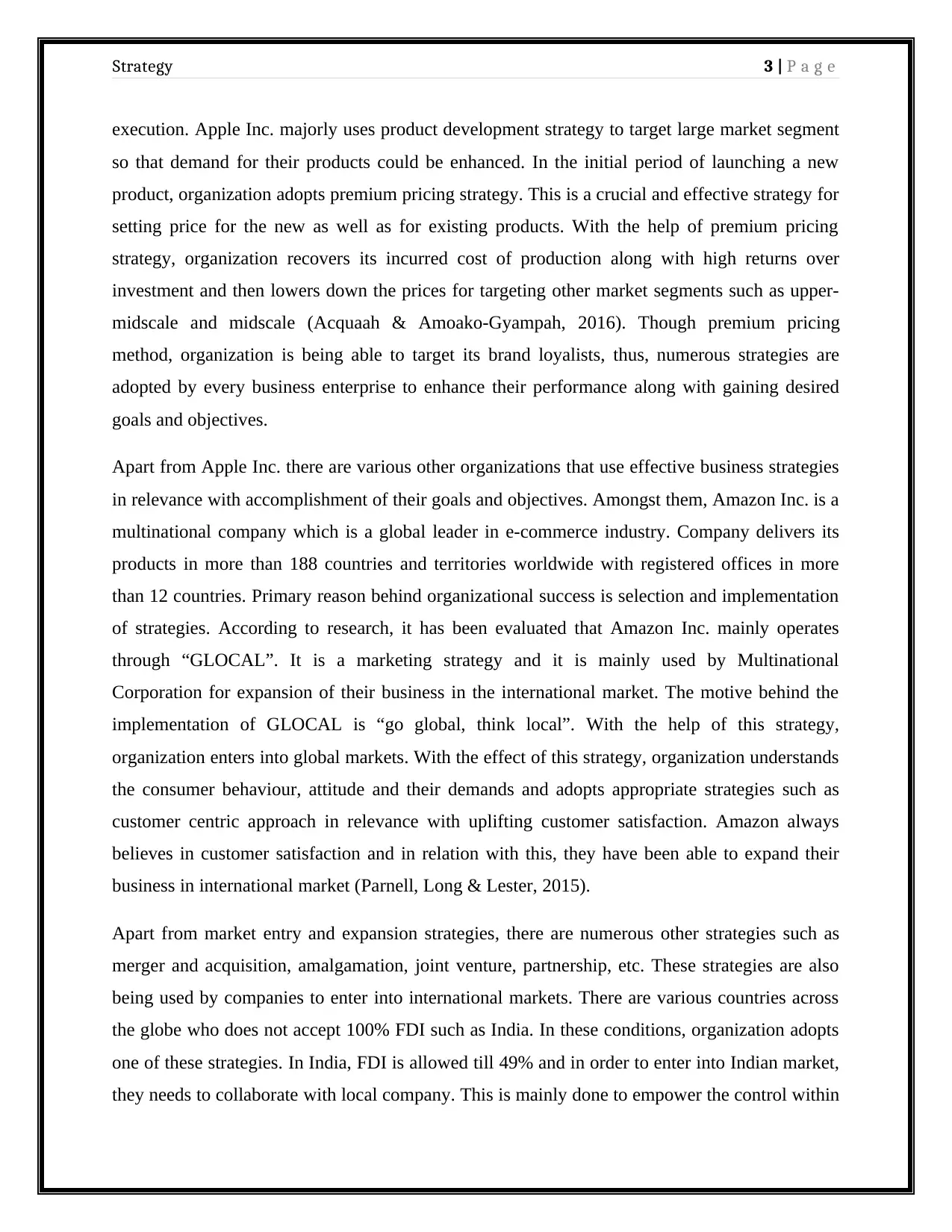
Strategy 3 | P a g e
execution. Apple Inc. majorly uses product development strategy to target large market segment
so that demand for their products could be enhanced. In the initial period of launching a new
product, organization adopts premium pricing strategy. This is a crucial and effective strategy for
setting price for the new as well as for existing products. With the help of premium pricing
strategy, organization recovers its incurred cost of production along with high returns over
investment and then lowers down the prices for targeting other market segments such as upper-
midscale and midscale (Acquaah & Amoako-Gyampah, 2016). Though premium pricing
method, organization is being able to target its brand loyalists, thus, numerous strategies are
adopted by every business enterprise to enhance their performance along with gaining desired
goals and objectives.
Apart from Apple Inc. there are various other organizations that use effective business strategies
in relevance with accomplishment of their goals and objectives. Amongst them, Amazon Inc. is a
multinational company which is a global leader in e-commerce industry. Company delivers its
products in more than 188 countries and territories worldwide with registered offices in more
than 12 countries. Primary reason behind organizational success is selection and implementation
of strategies. According to research, it has been evaluated that Amazon Inc. mainly operates
through “GLOCAL”. It is a marketing strategy and it is mainly used by Multinational
Corporation for expansion of their business in the international market. The motive behind the
implementation of GLOCAL is “go global, think local”. With the help of this strategy,
organization enters into global markets. With the effect of this strategy, organization understands
the consumer behaviour, attitude and their demands and adopts appropriate strategies such as
customer centric approach in relevance with uplifting customer satisfaction. Amazon always
believes in customer satisfaction and in relation with this, they have been able to expand their
business in international market (Parnell, Long & Lester, 2015).
Apart from market entry and expansion strategies, there are numerous other strategies such as
merger and acquisition, amalgamation, joint venture, partnership, etc. These strategies are also
being used by companies to enter into international markets. There are various countries across
the globe who does not accept 100% FDI such as India. In these conditions, organization adopts
one of these strategies. In India, FDI is allowed till 49% and in order to enter into Indian market,
they needs to collaborate with local company. This is mainly done to empower the control within
execution. Apple Inc. majorly uses product development strategy to target large market segment
so that demand for their products could be enhanced. In the initial period of launching a new
product, organization adopts premium pricing strategy. This is a crucial and effective strategy for
setting price for the new as well as for existing products. With the help of premium pricing
strategy, organization recovers its incurred cost of production along with high returns over
investment and then lowers down the prices for targeting other market segments such as upper-
midscale and midscale (Acquaah & Amoako-Gyampah, 2016). Though premium pricing
method, organization is being able to target its brand loyalists, thus, numerous strategies are
adopted by every business enterprise to enhance their performance along with gaining desired
goals and objectives.
Apart from Apple Inc. there are various other organizations that use effective business strategies
in relevance with accomplishment of their goals and objectives. Amongst them, Amazon Inc. is a
multinational company which is a global leader in e-commerce industry. Company delivers its
products in more than 188 countries and territories worldwide with registered offices in more
than 12 countries. Primary reason behind organizational success is selection and implementation
of strategies. According to research, it has been evaluated that Amazon Inc. mainly operates
through “GLOCAL”. It is a marketing strategy and it is mainly used by Multinational
Corporation for expansion of their business in the international market. The motive behind the
implementation of GLOCAL is “go global, think local”. With the help of this strategy,
organization enters into global markets. With the effect of this strategy, organization understands
the consumer behaviour, attitude and their demands and adopts appropriate strategies such as
customer centric approach in relevance with uplifting customer satisfaction. Amazon always
believes in customer satisfaction and in relation with this, they have been able to expand their
business in international market (Parnell, Long & Lester, 2015).
Apart from market entry and expansion strategies, there are numerous other strategies such as
merger and acquisition, amalgamation, joint venture, partnership, etc. These strategies are also
being used by companies to enter into international markets. There are various countries across
the globe who does not accept 100% FDI such as India. In these conditions, organization adopts
one of these strategies. In India, FDI is allowed till 49% and in order to enter into Indian market,
they needs to collaborate with local company. This is mainly done to empower the control within
Paraphrase This Document
Need a fresh take? Get an instant paraphrase of this document with our AI Paraphraser
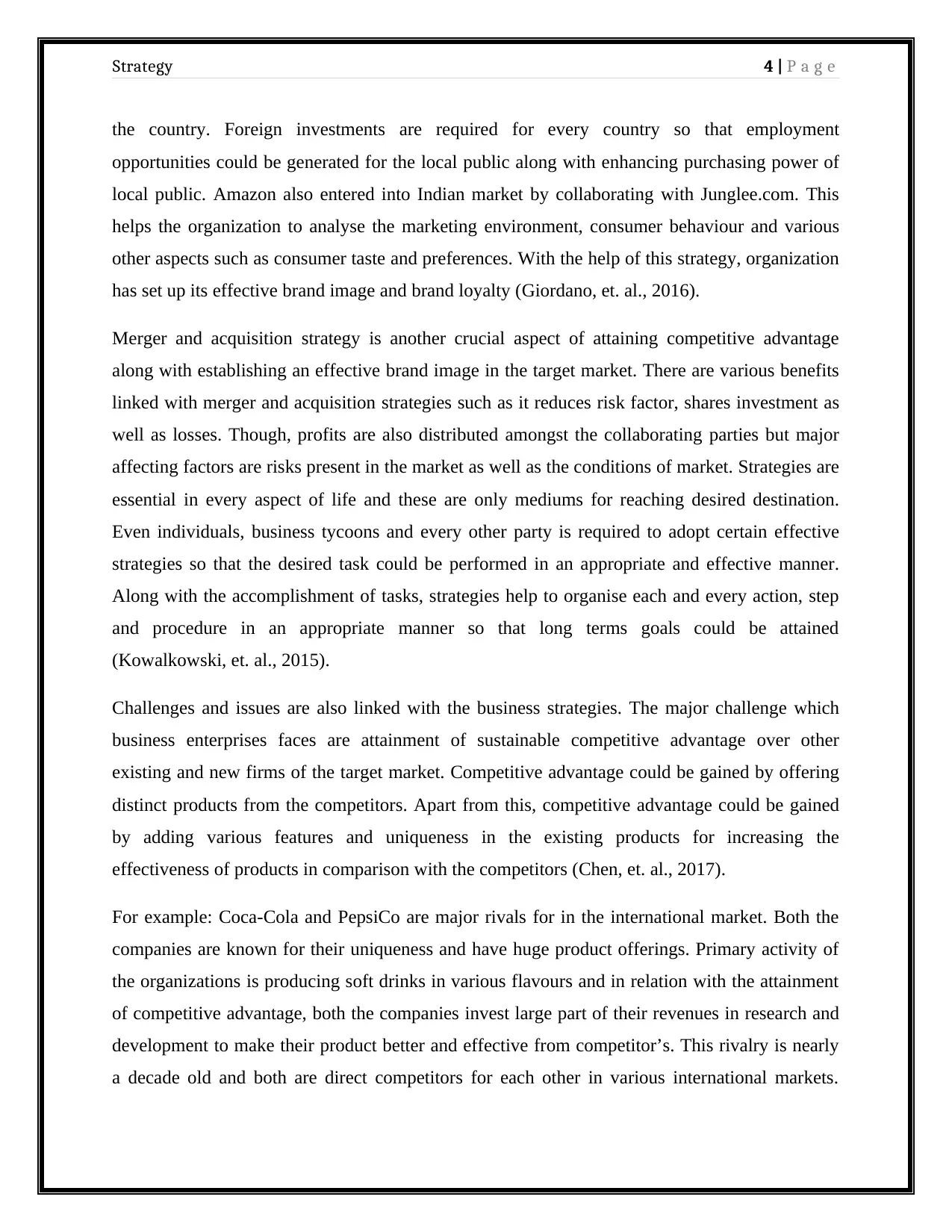
Strategy 4 | P a g e
the country. Foreign investments are required for every country so that employment
opportunities could be generated for the local public along with enhancing purchasing power of
local public. Amazon also entered into Indian market by collaborating with Junglee.com. This
helps the organization to analyse the marketing environment, consumer behaviour and various
other aspects such as consumer taste and preferences. With the help of this strategy, organization
has set up its effective brand image and brand loyalty (Giordano, et. al., 2016).
Merger and acquisition strategy is another crucial aspect of attaining competitive advantage
along with establishing an effective brand image in the target market. There are various benefits
linked with merger and acquisition strategies such as it reduces risk factor, shares investment as
well as losses. Though, profits are also distributed amongst the collaborating parties but major
affecting factors are risks present in the market as well as the conditions of market. Strategies are
essential in every aspect of life and these are only mediums for reaching desired destination.
Even individuals, business tycoons and every other party is required to adopt certain effective
strategies so that the desired task could be performed in an appropriate and effective manner.
Along with the accomplishment of tasks, strategies help to organise each and every action, step
and procedure in an appropriate manner so that long terms goals could be attained
(Kowalkowski, et. al., 2015).
Challenges and issues are also linked with the business strategies. The major challenge which
business enterprises faces are attainment of sustainable competitive advantage over other
existing and new firms of the target market. Competitive advantage could be gained by offering
distinct products from the competitors. Apart from this, competitive advantage could be gained
by adding various features and uniqueness in the existing products for increasing the
effectiveness of products in comparison with the competitors (Chen, et. al., 2017).
For example: Coca-Cola and PepsiCo are major rivals for in the international market. Both the
companies are known for their uniqueness and have huge product offerings. Primary activity of
the organizations is producing soft drinks in various flavours and in relation with the attainment
of competitive advantage, both the companies invest large part of their revenues in research and
development to make their product better and effective from competitor’s. This rivalry is nearly
a decade old and both are direct competitors for each other in various international markets.
the country. Foreign investments are required for every country so that employment
opportunities could be generated for the local public along with enhancing purchasing power of
local public. Amazon also entered into Indian market by collaborating with Junglee.com. This
helps the organization to analyse the marketing environment, consumer behaviour and various
other aspects such as consumer taste and preferences. With the help of this strategy, organization
has set up its effective brand image and brand loyalty (Giordano, et. al., 2016).
Merger and acquisition strategy is another crucial aspect of attaining competitive advantage
along with establishing an effective brand image in the target market. There are various benefits
linked with merger and acquisition strategies such as it reduces risk factor, shares investment as
well as losses. Though, profits are also distributed amongst the collaborating parties but major
affecting factors are risks present in the market as well as the conditions of market. Strategies are
essential in every aspect of life and these are only mediums for reaching desired destination.
Even individuals, business tycoons and every other party is required to adopt certain effective
strategies so that the desired task could be performed in an appropriate and effective manner.
Along with the accomplishment of tasks, strategies help to organise each and every action, step
and procedure in an appropriate manner so that long terms goals could be attained
(Kowalkowski, et. al., 2015).
Challenges and issues are also linked with the business strategies. The major challenge which
business enterprises faces are attainment of sustainable competitive advantage over other
existing and new firms of the target market. Competitive advantage could be gained by offering
distinct products from the competitors. Apart from this, competitive advantage could be gained
by adding various features and uniqueness in the existing products for increasing the
effectiveness of products in comparison with the competitors (Chen, et. al., 2017).
For example: Coca-Cola and PepsiCo are major rivals for in the international market. Both the
companies are known for their uniqueness and have huge product offerings. Primary activity of
the organizations is producing soft drinks in various flavours and in relation with the attainment
of competitive advantage, both the companies invest large part of their revenues in research and
development to make their product better and effective from competitor’s. This rivalry is nearly
a decade old and both are direct competitors for each other in various international markets.
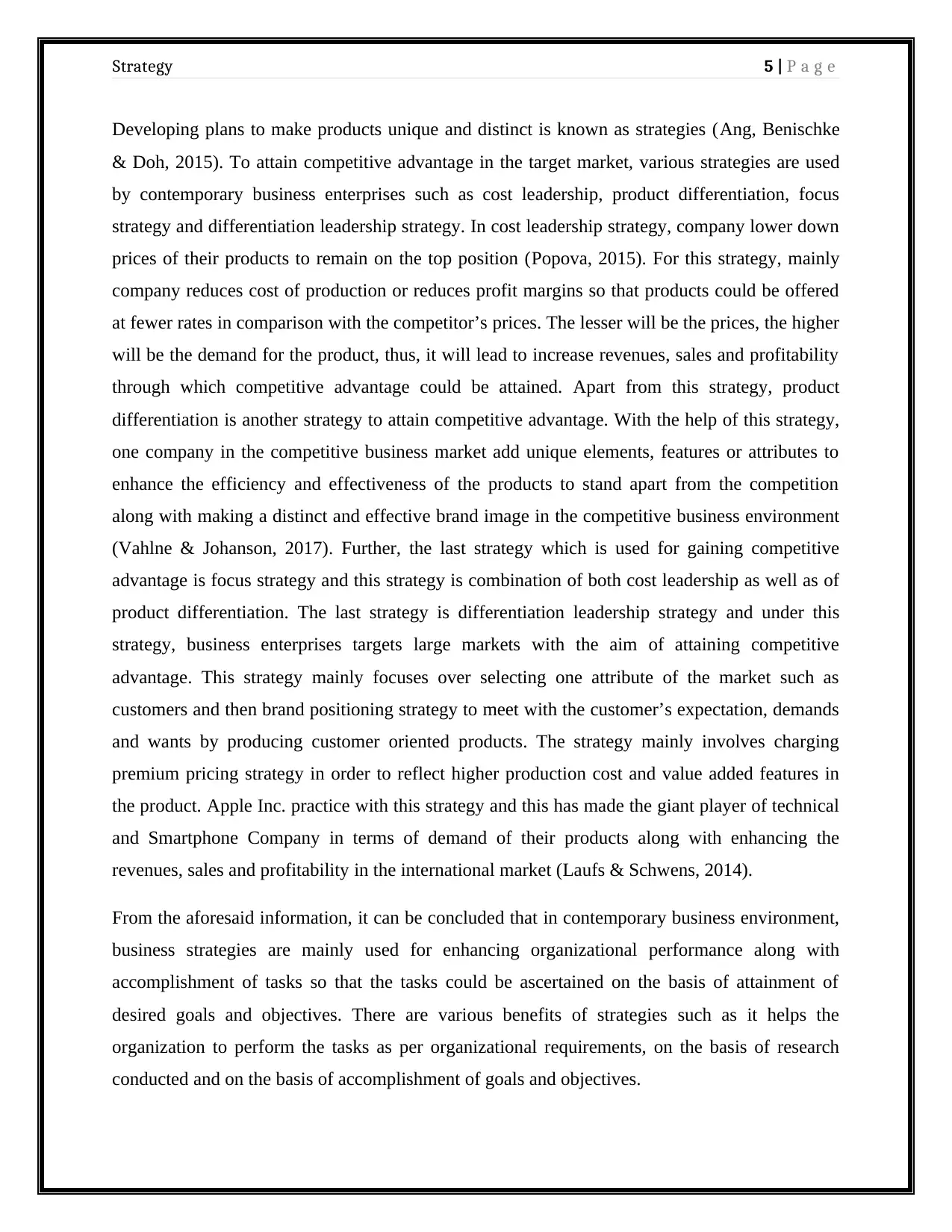
Strategy 5 | P a g e
Developing plans to make products unique and distinct is known as strategies (Ang, Benischke
& Doh, 2015). To attain competitive advantage in the target market, various strategies are used
by contemporary business enterprises such as cost leadership, product differentiation, focus
strategy and differentiation leadership strategy. In cost leadership strategy, company lower down
prices of their products to remain on the top position (Popova, 2015). For this strategy, mainly
company reduces cost of production or reduces profit margins so that products could be offered
at fewer rates in comparison with the competitor’s prices. The lesser will be the prices, the higher
will be the demand for the product, thus, it will lead to increase revenues, sales and profitability
through which competitive advantage could be attained. Apart from this strategy, product
differentiation is another strategy to attain competitive advantage. With the help of this strategy,
one company in the competitive business market add unique elements, features or attributes to
enhance the efficiency and effectiveness of the products to stand apart from the competition
along with making a distinct and effective brand image in the competitive business environment
(Vahlne & Johanson, 2017). Further, the last strategy which is used for gaining competitive
advantage is focus strategy and this strategy is combination of both cost leadership as well as of
product differentiation. The last strategy is differentiation leadership strategy and under this
strategy, business enterprises targets large markets with the aim of attaining competitive
advantage. This strategy mainly focuses over selecting one attribute of the market such as
customers and then brand positioning strategy to meet with the customer’s expectation, demands
and wants by producing customer oriented products. The strategy mainly involves charging
premium pricing strategy in order to reflect higher production cost and value added features in
the product. Apple Inc. practice with this strategy and this has made the giant player of technical
and Smartphone Company in terms of demand of their products along with enhancing the
revenues, sales and profitability in the international market (Laufs & Schwens, 2014).
From the aforesaid information, it can be concluded that in contemporary business environment,
business strategies are mainly used for enhancing organizational performance along with
accomplishment of tasks so that the tasks could be ascertained on the basis of attainment of
desired goals and objectives. There are various benefits of strategies such as it helps the
organization to perform the tasks as per organizational requirements, on the basis of research
conducted and on the basis of accomplishment of goals and objectives.
Developing plans to make products unique and distinct is known as strategies (Ang, Benischke
& Doh, 2015). To attain competitive advantage in the target market, various strategies are used
by contemporary business enterprises such as cost leadership, product differentiation, focus
strategy and differentiation leadership strategy. In cost leadership strategy, company lower down
prices of their products to remain on the top position (Popova, 2015). For this strategy, mainly
company reduces cost of production or reduces profit margins so that products could be offered
at fewer rates in comparison with the competitor’s prices. The lesser will be the prices, the higher
will be the demand for the product, thus, it will lead to increase revenues, sales and profitability
through which competitive advantage could be attained. Apart from this strategy, product
differentiation is another strategy to attain competitive advantage. With the help of this strategy,
one company in the competitive business market add unique elements, features or attributes to
enhance the efficiency and effectiveness of the products to stand apart from the competition
along with making a distinct and effective brand image in the competitive business environment
(Vahlne & Johanson, 2017). Further, the last strategy which is used for gaining competitive
advantage is focus strategy and this strategy is combination of both cost leadership as well as of
product differentiation. The last strategy is differentiation leadership strategy and under this
strategy, business enterprises targets large markets with the aim of attaining competitive
advantage. This strategy mainly focuses over selecting one attribute of the market such as
customers and then brand positioning strategy to meet with the customer’s expectation, demands
and wants by producing customer oriented products. The strategy mainly involves charging
premium pricing strategy in order to reflect higher production cost and value added features in
the product. Apple Inc. practice with this strategy and this has made the giant player of technical
and Smartphone Company in terms of demand of their products along with enhancing the
revenues, sales and profitability in the international market (Laufs & Schwens, 2014).
From the aforesaid information, it can be concluded that in contemporary business environment,
business strategies are mainly used for enhancing organizational performance along with
accomplishment of tasks so that the tasks could be ascertained on the basis of attainment of
desired goals and objectives. There are various benefits of strategies such as it helps the
organization to perform the tasks as per organizational requirements, on the basis of research
conducted and on the basis of accomplishment of goals and objectives.
⊘ This is a preview!⊘
Do you want full access?
Subscribe today to unlock all pages.

Trusted by 1+ million students worldwide
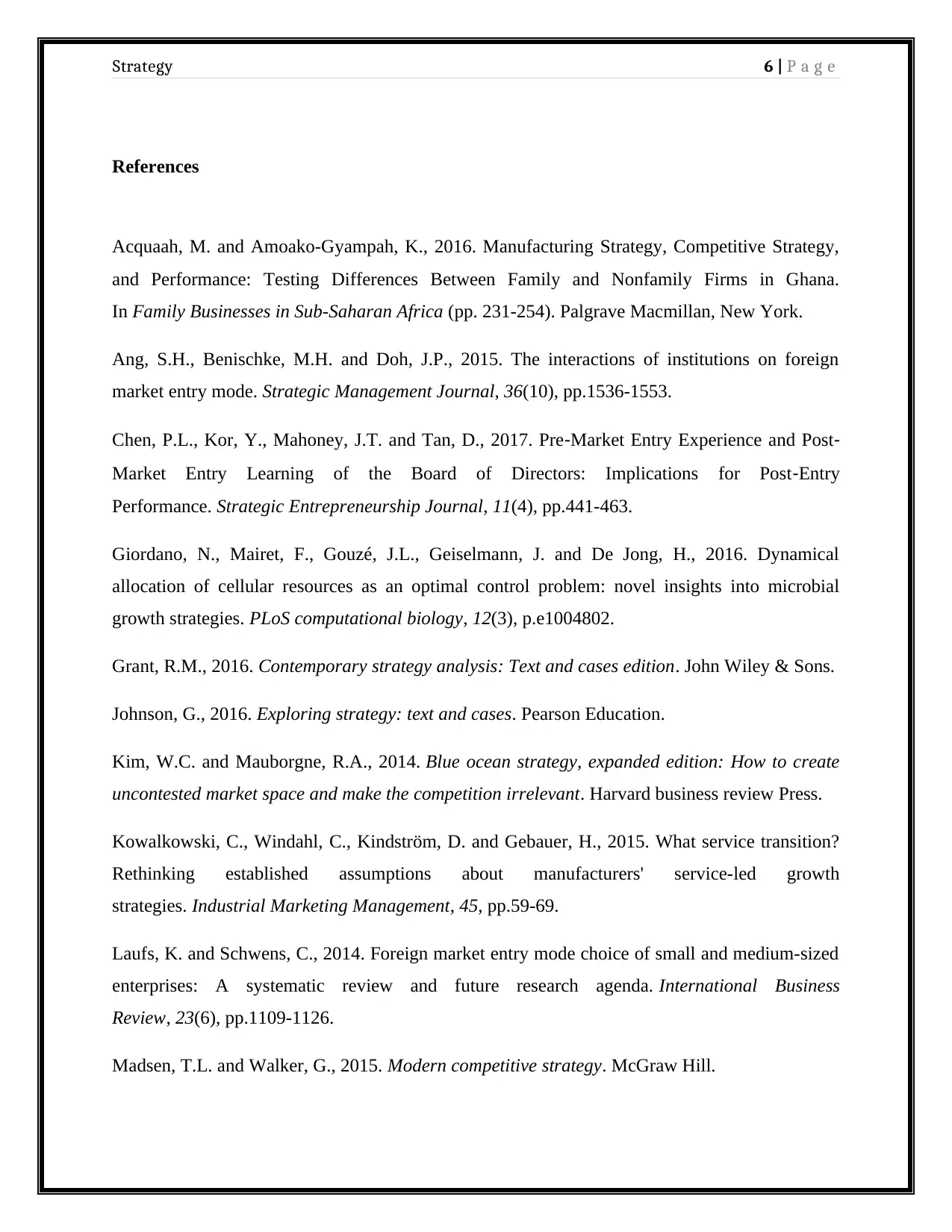
Strategy 6 | P a g e
References
Acquaah, M. and Amoako-Gyampah, K., 2016. Manufacturing Strategy, Competitive Strategy,
and Performance: Testing Differences Between Family and Nonfamily Firms in Ghana.
In Family Businesses in Sub-Saharan Africa (pp. 231-254). Palgrave Macmillan, New York.
Ang, S.H., Benischke, M.H. and Doh, J.P., 2015. The interactions of institutions on foreign
market entry mode. Strategic Management Journal, 36(10), pp.1536-1553.
Chen, P.L., Kor, Y., Mahoney, J.T. and Tan, D., 2017. Pre‐Market Entry Experience and Post‐
Market Entry Learning of the Board of Directors: Implications for Post‐Entry
Performance. Strategic Entrepreneurship Journal, 11(4), pp.441-463.
Giordano, N., Mairet, F., Gouzé, J.L., Geiselmann, J. and De Jong, H., 2016. Dynamical
allocation of cellular resources as an optimal control problem: novel insights into microbial
growth strategies. PLoS computational biology, 12(3), p.e1004802.
Grant, R.M., 2016. Contemporary strategy analysis: Text and cases edition. John Wiley & Sons.
Johnson, G., 2016. Exploring strategy: text and cases. Pearson Education.
Kim, W.C. and Mauborgne, R.A., 2014. Blue ocean strategy, expanded edition: How to create
uncontested market space and make the competition irrelevant. Harvard business review Press.
Kowalkowski, C., Windahl, C., Kindström, D. and Gebauer, H., 2015. What service transition?
Rethinking established assumptions about manufacturers' service-led growth
strategies. Industrial Marketing Management, 45, pp.59-69.
Laufs, K. and Schwens, C., 2014. Foreign market entry mode choice of small and medium-sized
enterprises: A systematic review and future research agenda. International Business
Review, 23(6), pp.1109-1126.
Madsen, T.L. and Walker, G., 2015. Modern competitive strategy. McGraw Hill.
References
Acquaah, M. and Amoako-Gyampah, K., 2016. Manufacturing Strategy, Competitive Strategy,
and Performance: Testing Differences Between Family and Nonfamily Firms in Ghana.
In Family Businesses in Sub-Saharan Africa (pp. 231-254). Palgrave Macmillan, New York.
Ang, S.H., Benischke, M.H. and Doh, J.P., 2015. The interactions of institutions on foreign
market entry mode. Strategic Management Journal, 36(10), pp.1536-1553.
Chen, P.L., Kor, Y., Mahoney, J.T. and Tan, D., 2017. Pre‐Market Entry Experience and Post‐
Market Entry Learning of the Board of Directors: Implications for Post‐Entry
Performance. Strategic Entrepreneurship Journal, 11(4), pp.441-463.
Giordano, N., Mairet, F., Gouzé, J.L., Geiselmann, J. and De Jong, H., 2016. Dynamical
allocation of cellular resources as an optimal control problem: novel insights into microbial
growth strategies. PLoS computational biology, 12(3), p.e1004802.
Grant, R.M., 2016. Contemporary strategy analysis: Text and cases edition. John Wiley & Sons.
Johnson, G., 2016. Exploring strategy: text and cases. Pearson Education.
Kim, W.C. and Mauborgne, R.A., 2014. Blue ocean strategy, expanded edition: How to create
uncontested market space and make the competition irrelevant. Harvard business review Press.
Kowalkowski, C., Windahl, C., Kindström, D. and Gebauer, H., 2015. What service transition?
Rethinking established assumptions about manufacturers' service-led growth
strategies. Industrial Marketing Management, 45, pp.59-69.
Laufs, K. and Schwens, C., 2014. Foreign market entry mode choice of small and medium-sized
enterprises: A systematic review and future research agenda. International Business
Review, 23(6), pp.1109-1126.
Madsen, T.L. and Walker, G., 2015. Modern competitive strategy. McGraw Hill.
Paraphrase This Document
Need a fresh take? Get an instant paraphrase of this document with our AI Paraphraser
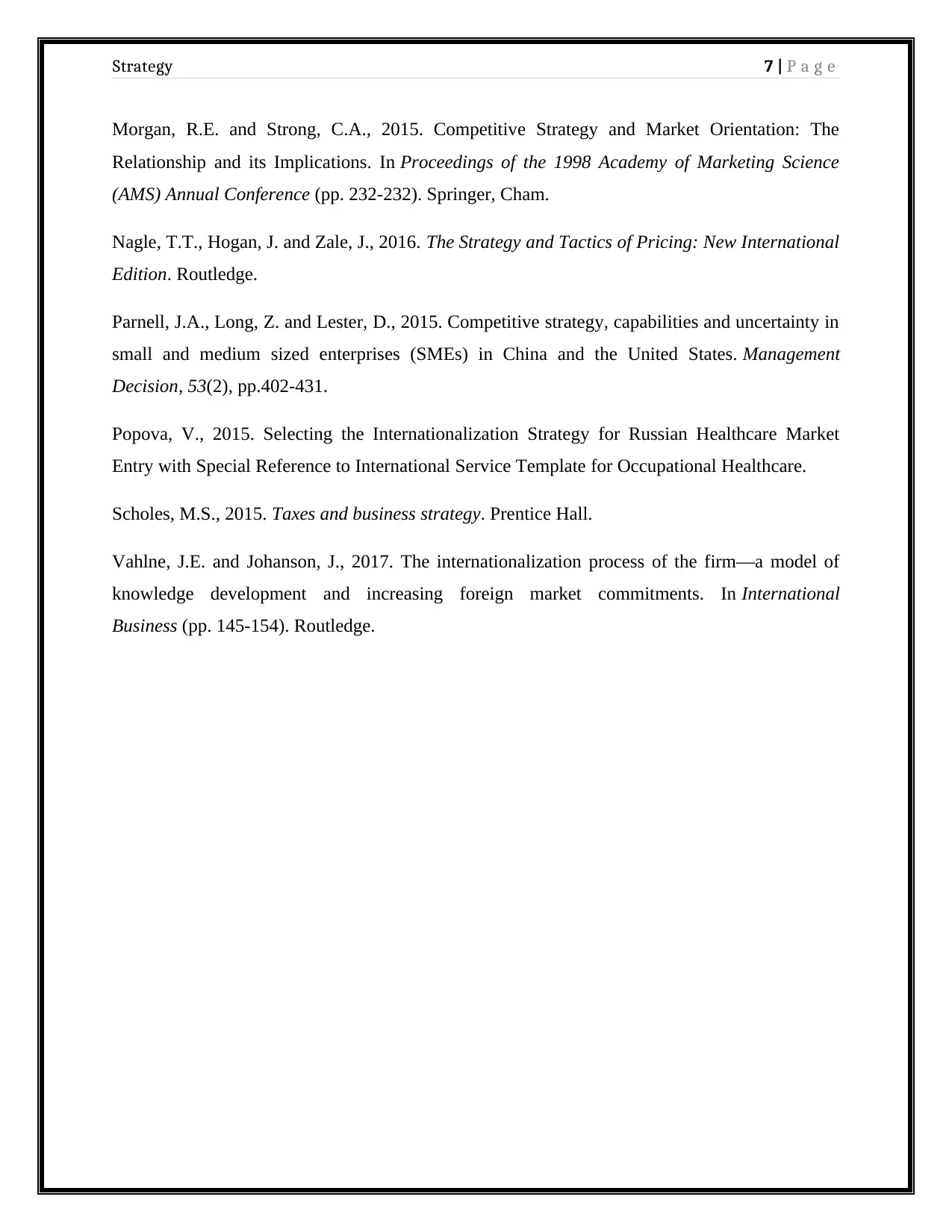
Strategy 7 | P a g e
Morgan, R.E. and Strong, C.A., 2015. Competitive Strategy and Market Orientation: The
Relationship and its Implications. In Proceedings of the 1998 Academy of Marketing Science
(AMS) Annual Conference (pp. 232-232). Springer, Cham.
Nagle, T.T., Hogan, J. and Zale, J., 2016. The Strategy and Tactics of Pricing: New International
Edition. Routledge.
Parnell, J.A., Long, Z. and Lester, D., 2015. Competitive strategy, capabilities and uncertainty in
small and medium sized enterprises (SMEs) in China and the United States. Management
Decision, 53(2), pp.402-431.
Popova, V., 2015. Selecting the Internationalization Strategy for Russian Healthcare Market
Entry with Special Reference to International Service Template for Occupational Healthcare.
Scholes, M.S., 2015. Taxes and business strategy. Prentice Hall.
Vahlne, J.E. and Johanson, J., 2017. The internationalization process of the firm—a model of
knowledge development and increasing foreign market commitments. In International
Business (pp. 145-154). Routledge.
Morgan, R.E. and Strong, C.A., 2015. Competitive Strategy and Market Orientation: The
Relationship and its Implications. In Proceedings of the 1998 Academy of Marketing Science
(AMS) Annual Conference (pp. 232-232). Springer, Cham.
Nagle, T.T., Hogan, J. and Zale, J., 2016. The Strategy and Tactics of Pricing: New International
Edition. Routledge.
Parnell, J.A., Long, Z. and Lester, D., 2015. Competitive strategy, capabilities and uncertainty in
small and medium sized enterprises (SMEs) in China and the United States. Management
Decision, 53(2), pp.402-431.
Popova, V., 2015. Selecting the Internationalization Strategy for Russian Healthcare Market
Entry with Special Reference to International Service Template for Occupational Healthcare.
Scholes, M.S., 2015. Taxes and business strategy. Prentice Hall.
Vahlne, J.E. and Johanson, J., 2017. The internationalization process of the firm—a model of
knowledge development and increasing foreign market commitments. In International
Business (pp. 145-154). Routledge.
1 out of 8
Related Documents
Your All-in-One AI-Powered Toolkit for Academic Success.
+13062052269
info@desklib.com
Available 24*7 on WhatsApp / Email
![[object Object]](/_next/static/media/star-bottom.7253800d.svg)
Unlock your academic potential
Copyright © 2020–2025 A2Z Services. All Rights Reserved. Developed and managed by ZUCOL.





